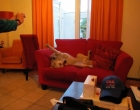
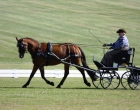
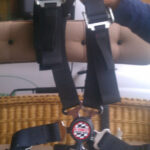 |
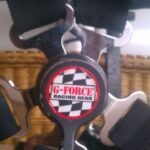 |
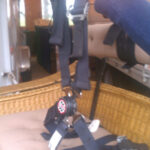 |
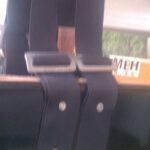 |
A five point harness attached to a beautiful whicker carriage allowing the driver to be secured even in a unmodified carriage.
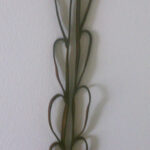
These loop reins can be made by both Smuckers and Hunt Harness and can be used by drivers with mobility issues in their hands allowing them to lengthen or shorten their reins as needed. www.smuckersharness.com
Available for purchase at Driving Essentials www.drivingessentials.com
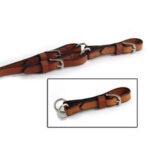 Double Reins Coupling Easily attaches 2 sets of reins to a bit, with each set creating identical pull and leverage pressure. Russet leather with brass or stainless. Made in USA.
Double Reins Coupling Easily attaches 2 sets of reins to a bit, with each set creating identical pull and leverage pressure. Russet leather with brass or stainless. Made in USA.
Driving Essentials generously offers a 5% cash back rewards program to all PATH International members.
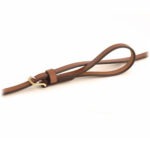 Rein Hand Holds These handy leather rein hand holds will easily fit over your existing leather reins, providing a secure grip for your drivers. Russet leather with brass or stainless buckles. Made in USA.
Rein Hand Holds These handy leather rein hand holds will easily fit over your existing leather reins, providing a secure grip for your drivers. Russet leather with brass or stainless buckles. Made in USA.
Driving Essentials generously offers a 5% cash back rewards program to all PATH International members.
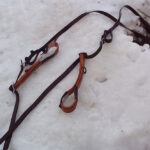 These loops are made of thick durable leather. They can be easily attached to a set of reins without having to punch holes in the ends. They simply thread through and on. They offer more adjustability since you aren’t restricted to whole spacing, but that adjustability makes it difficult to keep your reins even without marking them. These reins have some rubber therabands wrapped around the handle along with a hair tie. The hair tie allows for the loop to be kept tight around the drivers wrist, but is also breakable in case of an emergency. The theraband serves (though not well) to keep the hair ties from sliding, leaving the loops to pull off. The picture shows the loops buckled on the end of one set of reins (right side) with an auxiliary set buckled to the top (left side) that feeds to either side of the driver and back to the groom stand where the able-bodied driver can then assist if necessary. This looks a bit like a tandem set up making one long rein. The second rein buckles on top of the drivers hands to keep the weight of the buckle from bouncing on the horses mouth. These chariot loops can be purchased from Ideal Harness at www.idealharness.com though you may need to ask for them specially.
These loops are made of thick durable leather. They can be easily attached to a set of reins without having to punch holes in the ends. They simply thread through and on. They offer more adjustability since you aren’t restricted to whole spacing, but that adjustability makes it difficult to keep your reins even without marking them. These reins have some rubber therabands wrapped around the handle along with a hair tie. The hair tie allows for the loop to be kept tight around the drivers wrist, but is also breakable in case of an emergency. The theraband serves (though not well) to keep the hair ties from sliding, leaving the loops to pull off. The picture shows the loops buckled on the end of one set of reins (right side) with an auxiliary set buckled to the top (left side) that feeds to either side of the driver and back to the groom stand where the able-bodied driver can then assist if necessary. This looks a bit like a tandem set up making one long rein. The second rein buckles on top of the drivers hands to keep the weight of the buckle from bouncing on the horses mouth. These chariot loops can be purchased from Ideal Harness at www.idealharness.com though you may need to ask for them specially.
 |
Whip holder with a built up grip made out of PVC available at any hardware store. The T-piece to the left is a stopper for the hand. |
 |
In this photo the thumb holder wraps around the whip handle just like an able-bodied persons would. The velcro on the end wraps around adhering to the top of the wrist. |
 |
This photo shows a velcro strap running through the bottom of the whip holder. |
This set up is not the best. It tends to fall off during long bouts of use and has a hard time staying in place during the marathon section when competing. It does let the driver be in complete control though, which is worth its hassle. Feel free to take note of it and make any design changes you can think of. Just be sure to share with us!